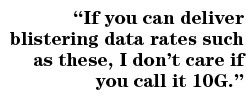Carriers Pulling Fast One with 4G Label? Yes, and Everybody Wins.
There’s a lot of mistrust out there when it comes to the major wireless service providers. And who could blame people for being skeptical? Just this week, Verizon Wireless agreed to pay the U.S. Treasury $25 million for erroneously charging customers for wireless Internet use—and that’s on top of another $52 million in customer refunds. The latest controversy surrounds the use of the term 4G, which is meant to describe new high-speed networks that mobile operators are rolling out across the U.S. As it turns out, none of the technologies the carriers are using officially meet the litmus test set by the International Telecommunications Union, which has many crying foul. I say quit your whining.
According to the ITU, in order for a mobile broadband technology to meet the 4G threshold, it must deliver at least 100 Mbps downloads. That means Sprint and Clearwire’s Mobile WiMax (3 to 6 Mbps), T-Mobile’s HSPA+ (5 to 8 Mbps), and even Verizon Wireless’ LTE network (5 to 12 Mbps) don’t even come close to deserving the 4G moniker. The standards body says that only WiMax 2 and LTE Advanced, which are years away, truly qualify. So is it somewhat disingenuous for carriers to trumpet 4G? Yes, but it’s also an effective way to market what truly is a leap in performance.
Now that Sprint has officially launched 4G in the New York City area, I’ve been testing one of the carrier’s laptop connection cards in both 3G and 4G modes. And the difference is truly dramatic. Over 4G, I’ve seen download speeds range from 1.92 Mbps on the low end to as high as 7.55 Mbps. When I switched to 3G, downloads dropped to between 200 Kbps and 400 Kbps. For those scoring at home, that’s an increase of about 13x. If you can deliver blistering data rates such as these, I don’t care if you call it 10G.
But what do these numbers really mean? Full web sites, including ESPN.com and NYTimes.com, fully loaded in between 5 and 7 seconds, instead of 17 to 24 seconds. And I saw a huge advantage when watching videos on such sites as Hulu. When I tried to watch a recent episode of Family Guy, it took less than 12 seconds for the video to start playing over 4G, and 30 seconds or more over 3G. Video playback over 4G was smooth even at full screen, with the exception of one annoying dropped connection. But when I tried to stream the same episode over 3G, it stuttered so much that I just stopped trying.
Although I haven’t had as much time with T-Mobile’s HSPA+ network, I’ve been impressed with the speeds its new myTouch 4G phone offers. On my commute home, I used the handset as a mobile hotspot, and it notched downloads consistently from 1.5 to 2 Mbps. That’s pretty darn good for a moving vehicle, and data rates have exceeded 5 Mbps in New York City when stationary. Having “4G” also means the difference between being able to make video calls on the go versus having to use a Wi-Fi hotspot, which just happens to be the focus of a new T-Mobile ad. Unfortunately, the quality of the video calls has been lackluster thus far, which I blame more on the software than the network.
The biggest problem I have with both Sprint and T-Mobile’s 4G networks are that they’re not widespread yet. Even in our midtown Manhattan office, the myTouch 4G often falls back to the slower 2.5G EDGE network. That’s a huge drop-off. In the case of Sprint, its coverage map for NYC has plenty of holes as well. Nevertheless, these issues are to be expected when you’re revamping your network.
According to Sprint, it now covers 61 markets with Mobile WiMax, while T-Mobile has 75 major metro areas blanketed in HSPA+. Verizon Wireless promises to cover 35 markets by the end of the year with its faster LTE network, but at first devices will be limited to laptop connection cards, with phones to follow. Sprint and T-Mobile have handsets now. Although AT&T claims that it will have HSPA+ rolled out to 250 million people by the end of this month, for now it doesn’t have any phones that offer these speeds.
Sign up to receive The Snapshot, a free special dispatch from Laptop Mag, in your inbox.
While I certainly wish these next-generation mobile broadband networks were available everywhere, fighting over what to call them misses the point. What’s more important is how much faster today’s “4G” is than 3G, and the answer is very. Let’s concentrate on more important things, such as determining which of these networks offers the best performance and value. That’s what consumers will care about.
Editor-in-chief Mark Spoonauer directs LAPTOP's online and print editorial content and has been covering mobile and wireless technology for over a decade. Each week Mark's SpoonFed column provides his insights and analysis of the biggest mobile trends and news. You can also follow him on Twitter.



